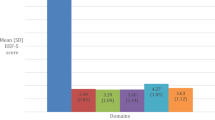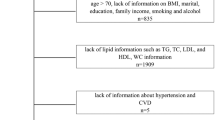Abstract
The purpose of this study was to determine the prevalence of ED and its health-related correlates in a nonselected population from a Mediterranean country. The abridged 5-item version of the international index of erectile function (IIEF-5) was used as a diagnostic tool. A total of 905 men aged 18 years and above from Jordan were included in the study and answered the questions about medical history, lifestyle habits and sexual behavior. A logistic regression model was used to identify significant independent risk factors for ED. In this sample the prevalence of all degrees of ED was estimated as 49.9%. In this group of men, the degree was mild in 25%, moderate in 13.5% and severe in 11.4%. The prevalence of severe ED increased from 2.7% in men in their twenties to 38.6% in their sixties and 46% in those aged 70 years and above. Age is the single most significant risk factor. Other important risk factors include lower household income, physical inactivity, obesity, smoking, diabetes mellitus hypertension and ischemic heart disease. This study provides a quantitative estimate of the prevalence and the main risk factors for ED in our region. This condition, which represents a source of distress, should be evaluated more effectively by rigorous and standardized methods, particularly as effective treatments are now available.
This is a preview of subscription content, access via your institution
Access options
Subscribe to this journal
Receive 8 print issues and online access
$259.00 per year
only $32.38 per issue
Buy this article
- Purchase on Springer Link
- Instant access to full article PDF
Prices may be subject to local taxes which are calculated during checkout


Similar content being viewed by others
References
Feldman HA, Goldstein I, Hatzichristou DG, Krane RJ, McKinlay JB . Impotence and its medical and psychosocial correlates: results of the Massachusetts male aging study. J Urol 1994; 151: 54–61.
Ayta IA, McKinlay JB, Krane RJ . The likely worldwide increase in erectile dysfunction between 1995 and 2025 and some possible policy consequences. BJU Int 1999; 84: 50–56.
Ansong KS, Lewis C, Jenkins P, Bell J . Epidemiology of erectile dysfunction: a community-based study in rural New York state. Ann Epidemiol 2000; 10: 293–296.
Blanker MH, Bosch JL, Groeneveld FP, Bohnen AM, Prins A, Thomas S et al. Erectile and ejaculatory dysfunction in a community-based sample of men 50–78 years old: prevalence, concern, and relation to sexual activity. Urology 2001; 57: 763–768.
Martin-Morales A, Sanchez-Cruz JJ, Saenz de Tejada I, Rodriguez-Vela L, Jimenez-Cruz JF, Burgos-Rodriguez R . Prevalence and independent risk factors for erectile dysfunction in Spain: results of the epidemiologia de la dysfuncion erectile masculina study. J Urol 2001; 166: 569–574.
Braun M, Wassmer G, Klotz T, Reifenrath B, Mathers M, Engelmann U . Epidemiology of erectile dysfunction: results of the ‘Cologne Male Survey’. Int J Impot Res 2000; 12: 305–311.
Chew KK, Earle CM, Stuckey BG, Jamrozik K, Keogh EJ . Erectile dysfunction in general practice: prevalence and clinical correlates. Int J Impot Res 2000; 12: 41–45.
Laumann EO, Paik A, Rosen RC . Sexual dysfunction in the United States. Prevalence and predictors. JAMA 1999; 281: 537–544.
Parazzini F, Menchini Fabris F, Bortolotti A, Calabrò A, Chatenoud L, Colli E et al. Frequency and determinants of erectile dysfunction in Italy. Eur Urol 2000; 37: 43–49.
Lyngdorf P, Hemmingsen L . Epidemiology of erectile dysfunction and its risk factors: a practice-based study in Denmark. Int J Impot Res 2004; 16: 105–111.
Tan JK, Hong CY, Png DJ, Liew LC, Wong ML . Erectile dysfunction in Singapore: prevalence and its associated factors—a population-based study. Singapore Med J 2003; 44: 20–26.
Johannes CB, Araujo AB, Feldman HA, Derby CA, Kleinman KP, McKinlay JB . Incidence of erectile dysfunction in men 40 to 69 years old: longitudinal results from the Massachusetts male aging study. J Urol 2000; 163: 460–463.
Giuliano F, Chevret-Measson M, Tsatsaris A, Reitz C, Murino M, Thonneau P . Prevalence of erectile dysfunction in France: results of an epidemiological survey of a representative sample of 1004 men. Eur Urol 2002; 42: 382–389.
McVary KT, Carrier S, Wessels H . The subcommittee on smoking and erectile dysfunction socio-economic committee, sexual medicine society of North America. Smoking and erectile dysfunction: evidence based analysis. J Urol 2001; 166: 1624–1632.
Rosen RC, Riley A, Wagner G, Osterloh IH, Kirpatrick J, Mishra A . The International Index of Erectile Function (IIEF): a multidimensional scale for assessment of erectile dysfunction. Urology 1997; 49: 822–830.
NIH consensus conference: impotence. NIH Consensus Development Panel on Impotence. JAMA 1993; 270: 83–90.
Masumori N, Tsukamoto T, Kumamoto Y, Panser LA, Rhodes T, Girman CJ et al. Decline of sexual function with age in Japanese men compared with American men—results of two community-based studies. Urology 1999; 54: 335–344.
Jonler M, Moon T, Brannan W, Stone NN, Heisey D, Bruskewitz RC . The effect of age, ethnicity and geographical location on impotence and quality of life. Br J Urol 1995; 75: 651–655.
Rosen RC, Cappelleri JC, Smith MD, Lipsky J, Peña BM . Development and evaluation of an abridged, 5-item version of the International Index of Erectile Function (IIEF-5) as a diagnostic tool for erectile dysfunction. Int J Impot Res 1999; 11: 319–326.
Safarinejad MR . Prevalence and risk factors for erectile dysfunction in a population-based study in Iran. Int J Impot Res 2003; 15: 246–252.
Nicolosi A, Moreira ED Jr, Shirai M, Bin Mohd Tambi MI, Glasser DB . Epidemiology of erectile dysfunction in four countries: cross-national study of the prevalence and correlates of erectile dysfunction. Urology 2003; 61:201–206.
Kongkanand A . Prevalence of erectile dysfunction in Thailand. Int J Androl 2000; 23 (Suppl 2): 77–80.
Rimm EB, Bacon CG, Giovannucci EL, Kawachi I . Body weight, physical activity, and alcohol consumption in relation to erectile dysfunction among U.S. male health professionals free of major chronic diseases. J Urol 2000; 163 (Suppl): 241.
Derby CA, Mohr BA, Goldstein I, Feldman HA, Johannes CB, McKinlay JB . Modifiable risk factors and erectile dysfunction: can lifestyle changes modify risk? Urology 2000; 56: 302–306.
Condra M, Morales A, Owen JA, Surridge DH, Fenemore J . Prevalence and significance of tobacco smoking in impotence. Urology 1986; 27: 495–499.
Austoni E, Mirone V, Parazzini F, Fasolo CB, Turchi P, Pescatori ES et al. Smoking as a risk factor for erectile dysfunction: data from the Andrology Prevention Weeks 2001–2002. A Study of the Italian Society of Andrology (S.I.A.). Eur Urol 2005; 48: 810–818.
El-sakka AI . Characteristics of erectile dysfunction in Saudi patients. Int J Impot Res 2004; 16: 13–20.
Ajlouni K, Khader YS, Batieha A, Ajlouni H, El-Khateeb M . An increase in the prevalence of diabetes mellitus in Jordan over 10 years. Diabetes Complications 2008; 22: 317–324.
El-Sakka AI, Tayeb KA . Erectile dysfunction risk factors in non-insulin dependant diabetic saudi patients. J Urol 2003; 169: 1043–1047.
McMahon CG, Althof S, Waldinger MD, Porst H, Dean J, Sharlip I et al. An evidence-based definition of lifelong premature ejaculation: report of the International Society for Sexual Medicine Ad Hoc Committee for the Definition of Premature Ejaculation. BJU Int 2008; 102: 338–350.
Author information
Authors and Affiliations
Corresponding author
Ethics declarations
Competing interests
The authors declare no conflict of interest.
Rights and permissions
About this article
Cite this article
Ghalayini, I., Al-Ghazo, M., Al-Azab, R. et al. Erectile dysfunction in a Mediterranean country: results of an epidemiological survey of a representative sample of men. Int J Impot Res 22, 196–203 (2010). https://doi.org/10.1038/ijir.2009.65
Received:
Revised:
Accepted:
Published:
Issue Date:
DOI: https://doi.org/10.1038/ijir.2009.65
Keywords
This article is cited by
-
Sexual Function and Satisfaction in the Context of Obesity
Current Diabetes Reports (2023)
-
Erectile dysfunction among patients and health care providers during COVID-19 pandemic: A systematic review
International Journal of Impotence Research (2022)
-
Associations between body mass index, waist circumference and erectile dysfunction: a systematic review and META-analysis
Reviews in Endocrine and Metabolic Disorders (2020)
-
Physical inactivity, gender and culture in Arab countries: a systematic assessment of the literature
BMC Public Health (2018)
-
From inflammation to sexual dysfunctions: a journey through diabetes, obesity, and metabolic syndrome
Journal of Endocrinological Investigation (2018)



